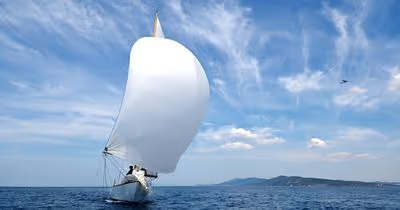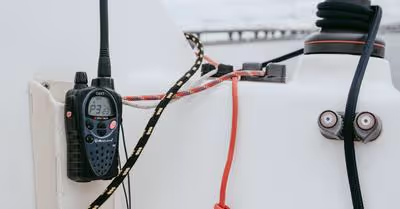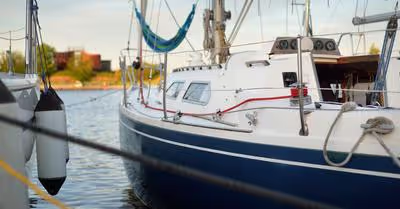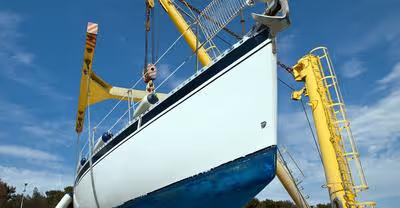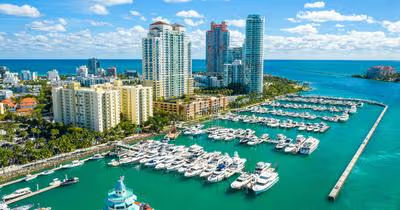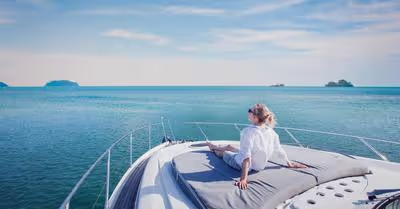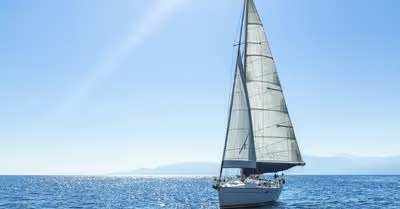Table of Contents
How to Tell if Your Sails Need Replacing?
If you are not participating in sailing competitions nor have any other yardstick to measure the condition of your sails, it can be hard to determine if your sails are in perfect condition or require replacing.
Sometimes, without an objective measurement criterion, you can be lured into a false sense of security and believe that your sails are working fine even when they are not. So, how can you avoid this and tell if your sails’ best days are behind them? Well, if you notice that your sails have become dangerously saggy or propel you upwind as effectively as they used to, it might be time for a replacement. It is important to replace the sails before you run into a self-destruct event.
Essentially, you should know that it is time to buy new sails if mending or replacing your current sails does not make much economic sense anymore. You should also consider replacing if your current sails simply do not work during the trimming. This is because your sailcloth will either completely break down or become so elastic that you will not be able to apply sufficient force to the corners or edges, even when sailing under light winds.
Kinds of Sails:
When shopping around for new sails, you need to have a basic idea about the different sail types. Below are the four most common kinds of sails:
1) Mainsails:
Mainsails consist of mizzens on ketches or yawls. These sails are the primary driving force, and need to be fitted with anywhere between one to four reefs. As far as incoming winds go, mainsails cover a large surface area, particularly when attached to the sailboat boom. Thanks to this larger surface area, mainsails do not need particularly powerful winds to propel the boat forward. Moreover, since the sailboat boom allows you to easily configure the position of the mainsail, all sail points can be easily accessed.
2) Foresails:
This category includes jibs and genoas, and is most commonly used in cutter-rigged boats. Generally, boats will have one curling roller foresail. However, a few boats comprise single-standing rails designed in a variety of sizes and shapes, and optimized for different wind strengths. For instance, smaller foresails can be used in calmer winds, while larger foresails are more effective at dealing with stronger winds.
Since foresails are not as large as mainsails, they also have smaller surface areas. However, if you are dealing with particularly strong winds, an adequately-trimmed mainsail will allow you to remove the mainsail and rely solely on your foresails – and this is actually an excellent technique for speed reduction.
3) Downwind Sails:
Downwind sails are asymmetric and symmetric spinnakers, along with cruising chutes and code zero.
4) Heavy Weather and Storm Sails:
These are trysails and storm jibs with a particular emphasis on safety. These sails are most suitable for offshore sailing where you are likely to encounter harsh weather conditions. Considering that a reefing genoas does not have the most competent shape – especially when it comes to heavy winds – we recommend going for a smaller but sturdier weather jib. You can set up the jib as part of an inner removable forest. In fact, this type of sails can be a critical addition to a sailing suit.
Assessing the Damage and Structural Strength of Your Sails:
When assessing your current sails for strength and damage, it is important to identify any areas that are prone to wear-and-tear. Even though you should examine every area and aspect of the sail, particular attention must be given to the spreader patches, leech, and inboard batten pockets. It is also vital to remember that the sun will first target the stitching on the sails before damaging the sails material. As you have already observed, new sails do not come cheap. So, if you think that re-stitching the affected areas might help extend your current sails’ life, you should consider going down that route first. There is a simple way to check the condition of the stitches: simply rub the fingers against them. If the stitches come out quickly, it is an indication of their fragility and that they require re-stitching. In this case, you should get the re-stitching done before things get worse.
Also check the leech to see if it is still in working order – you will need to poke your thumb into the leech’s weave fabric to make this examination. If the weave thread can be poked through, the leech is likely in poor condition. Do not forget to examine the batten pockets for any worn-out patches or other kinds of damage. Remember that, if you feel that the cost to repair or fix your current sails is too high, it is likely time for you to go for a replacement altogether.
Remember that the sails’ aging process is determined by several factors, including the ways in which they have been used, the kind of care that they have received, and the materials utilized. Hence, determining the life and condition of the sails solely on the basis of the number of water miles covered, is pretty much impossible. The vital thing to know is that sails can alter their shapes very gradually, which means that this change is not always apparent. For this reason, it is important that you conduct regular assessments of your sails to identify any changes to the shapes.
The above assessment method will not only help you check the shapes, but also the handling and consistency of the new sails. A new sail will not go from good to bad overnight, but will stretch as it ages, and this stretch is what brings about changes to the shapes. When the sails lose form and shape, they also lose the ability for accurate aiming, which makes steering a lot more difficult. Consequently, the boat will increase heel, drag, and ultimately slow down.
Factors that Determine the Cost of a Sail:
Although the cost of a sail is determined by several factors, the two most important considerations are sail quality and sail area. Remember that the voyage length is the primary determinant for the sail area.
So, the sail area is essentially the fabric amount that you will need for your boat. In general, longer vessels will need larger sails. However, if you are using a standard jib instead of genoas, you will require less fabric. As far as the sail quality goes, it is determined by the materials used in preparing the sail, the weave tightness, and the overall finishing quality. It is important to remember that, although you might get a lower-quality sail for cheaper, it will need to be replaced sooner. If you plan to keep your boat for a large amount of time, this will actually increase your costs in the long-run.
The main difference in sail quality (or sail type) resides in the offshore and inshore use. This means that, as far as cost is concerned, offshore sails generally provide better value for money compared to their inshore counterparts. An inshore sail, for instance, will have weaker clew patches, no double taping, and poorer stitching. The simple explanation for this is that an inshore sail is likely to encounter weaker winds. Besides, cruising sails are less expensive than running sails for a number of reasons, the most important of which is that the former have not been built to last.
Another factor that can impact the sail replacement cost is the number of sails. Also, remember that, for almost all regular keelboats, the rigging consists of a jib and a main. However, a lot of sailors add more sails to improve the boat’s performance and speed. In addition, the rig type determines the kinds of designs that you can use for your sails. Gaff rigs, for instance, go with quadrilateral sails, thereby increasing the sail area. Add a jib and a roller furling main, and the price goes up significantly.
The type of material is yet another important factor to consider when buying a new sail. Twenty years ago, woven Dacron was pretty much the only suitable material choice for sails, which meant that the only thing to consider was the grade for the Dacron grade: sailors looking to cruise could go for a stiffer yet more flexible form of the cloth, while a less flexible kind of Dacron was available for sailing boats. Today, however, we have a lot more choice with regards to sail materials, with each material offering its own set of advantages and drawbacks.
A lot of people believe that there is a good reason to go for modern cruising materials and designs. One of those reasons is that, the better the material and design is, the lighter your sail will be (assuming that the weight remains the same). Compared to bulkier or larger sails, lighter ones make for easier navigation. Besides, sails prepared using premium fabric are likely to last longer, compared to those designed using poorly or using low-grade material. Remember that the sail design will determine the load balance – the more evenly the load is spread across the sail, the less likely it is that the sail will break down or lose its shape. The cheapest sail does not always give you the best value for money – you also have to consider things like lifespan and durability.
Never forget to learn about the weight, manufacture, and form of the sail cloth that is recommended for your boat. For instance, woven polyester is the best choice for cruising sails. However, there are other options as well, including Ultra PE, Aramid, Nylon, and 3Di. You should reach out to multiple fabric manufacturers and obtain a quote for the sails. Sometimes, opting for unbranded cloth might be a good idea, as long as you are mindful about the quality and price options.
Cloth weight can prove to be a challenge, especially since the different units are often confusing. ‘Ounce per square yard’ or ‘grams per square foot’ seem simple enough. However, in certain cases, the yard in question might be sail-maker’s yard, which is a cloth piece that is 36 feet long and 28 feet wide in the US. This means that it is vital for you to know if the number is American, imperial, or metric.
Besides, in certain cases, a particular fabric brand will have its own weight that will not influence the actual cloth weight in any of the above schemes. As a rule of thumb, the heavier the cloth is, the stronger and more durable it should be, and the heavier it should make your sail.
Choosing the Sail Material:
As we mentioned, there is a lot of variety in terms of sail material. Below are some of the most common types of materials that are used to manufacture sails:
1) Woven Dacron:
Alongside being the oldest sail material, the woven Dacron is also one of the least expensive and most durable materials going around. The drawback is that it will lose shape quickly, and might not retain the right shape even though the actual material might still be good enough.
Remember that there are different types of Dacron. Cruising sailboats, for instance, use a specific kind of Dacron that has a permeated finish. This type of Dacron is created by soaking it in glue and binding the yarns together. Even though this approach increases durability and softness, it also causes the material to stretch more under stronger winds, particularly when the sail is still new.
Racing sailboats, meanwhile, use a different kind of Dacron. This kind is covered with a hard melamine finish, which helps in reducing the amount of stretch.
2) Hydrant Woven:
Hydrant woven sails contain Dyneema fibers, which increases resistance to chafe and ultraviolet radiation, while also enhancing durability and endurance. In addition, the Dyneema fibers can help the sails retain their original shape for longer.
3) Laminate Sails:
This type of sail is designed using two Mylar-film sheets containing structural load-bearing fibers between them. Many different kinds of fibers can be used, including Twaron, Kevlar, polyester, and carbon.
Carbon and polyester, however, tend to be costly, which means that the price of laminate sails is often on the higher side. Although these materials are much better at retaining their shape than other materials, they do not last long. However, to improve durability, makers integrate taffeta layers on either side, but this increases both the cost and the weight of the final material.
4) Membrane Sails/String Sails:
These sails are molded in a single piece with the help of fibers that have been aligned by adhering to the precise load paths of the sails. The fabrics are pretty much customized, and have been reinforced in certain places to ensure that they retain their original shape and stay durable.
Remember that these sails use high-end materials, which means that they are quite costly and almost always used only for racing boats. However, if you can afford these sails, there is no reason for you to not use them on a cruising sailboat. In fact, membrane or string sails are very suitable for longer voyages.
All in all, the two most important aspects to consider when choosing a sailboat material are shape retention and durability. Other than these, you should also consider the material weight. Even though woven Dacron is still the standard material for sails, you can make other choices as long as they are aligned to your specific needs and requirements. More importantly, you need to ensure that the material you choose is within your allocated budget.
Estimated Sail Cost According to Boat Length:
As mentioned previously, the exact cost of a new sail will depend upon the length and type of the sailcloth, the sail design, and the length of the boat. In this section, we will discuss the estimated cost of sail based on the boat length. Although these are only estimates, they should give you some idea as to what to expect when buying new sails for your boat. Once again, we strongly recommend obtaining quotes from multiple sail-makers, as they can guide you through all the factors involved in coming up with the final cost number for your sail. Below are the estimated costs for each length range:
Estimated Cost of Genoas and Jibs:
Estimated Cost of Mainsails:
Estimating the Sail Area:
To estimate the cost of the sails, you need to estimate the sail area for your boat. To do this, you need to multiply the total surface-area ratio with the hull length. For example, if your boat has an LOA of 30ft and a surface area of 20, the total sail area will be approximately 600 square-feet. Indeed, this is an extremely rough calculation, but will suffice for a quick cost estimate. However, you should certainly get the sails weighed before making the purchase.
Important Tips Regarding Purchasing New Sails:
1) Consider the Type of Sailing That You Want To Do:
Effective sailing requires you to balance two opposing forces. To put it differently, easy-to-handle sails are not necessarily the longest-lasting; the strongest sails need not be the lightest; and ‘cheap’ does not always translate to ‘cost-effective’. For every boat-owner, the combination of the above factors will be unique to their needs and budgets. So, it is important to consider the kind of sailing that you want to do, as well as the waters or locations that you are targeting. Other than that, also focus on the crew members who will be accompanying you, and the expected frequency with which you will sail.
2) Consider and Learn About the Measurements:
Like we said, the boat length is one of the most important factors to consider when buying a new sail. This is because the boat length will determine the sail area, which, in turn, will determine the amount of fabric required for your sail. If your sailboat design is popular and well-known, the sail-maker is likely to have sufficient information to come up with the perfect design. However, if you own a less common boat, we recommend making a few measurements and providing those to the maker, as this information will help them come up with an accurate quote for you. Generally, the maker will provide you with a form asking you about the boat measurements and any other information that they might require to choose the right sail type for your boat.
3) Pay Attention to the Details:
Will you opt for a launch sock or cruising chute, or can you consider upgrading to roller reefing? These decisions will help you determine the right sailcloth, construction, and design. Remember that there are more complicated panel layouts, like tri-radial and bi-radial constructions that offer significant technical benefits related to efficiency. However, in general, the more complex the construction is, the more expensive it is likely to be. Ideally, you want sails that will maximize the performance and durability of your boat, without forcing you to break the bank.
4) Pick the Right Design:
Alongside choosing the right fabric, you also need to pay attention to the design. Make sure that the new sails have an adequate number of reefs, and that each reef is sufficiently deep.
You will also have to decide whether you want to opt for long battens or go for shorter ones. If you use the sailboat (or are planning to use it) for racing, shorter battens are the best option. Short battens offer greater control with regards to acceleration, speed, and maneuvering ability. Long battens, meanwhile, are best suited for cruising boats – this is because, although longer battens are relatively expensive, they are also more durable.
Generally, sails come with a pair of reefs. However, if you want to indulge in offshore sailing, you should consider adding an extra reef. Three reefs will make it easier for you to cut the sails down to the required sizes under stormy or other harsh weather conditions – the third reef can reduce the length of the luff by at least 40-45%. If you plan to sail off on longer voyages, you can even go for four reefs, as this will completely do away with the need for trails.
How to Prolong the Useful Life of Your Sails
While it is true that sails cannot last forever, there are certainly a few measures you can take to maximize the useful life of your new (or current) sails:
- Avoid exposing the sails to unnecessary heat or light
- Motor the sails down if they are not being used
- Avoid extensive lugging or flogging
- Use the right halyard tension
- Take the sails off when they are not being used
- Protect the sails from UV rays and chafe
- Rinse your sails using fresh water, every now and then
- Dry your sails before you store them
Recent Articles





